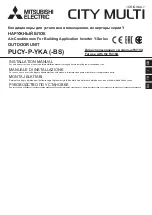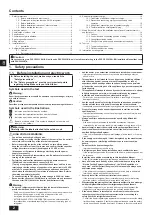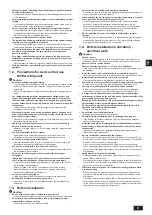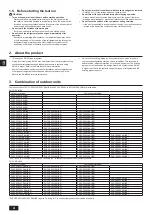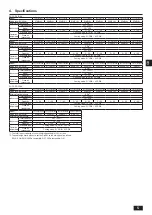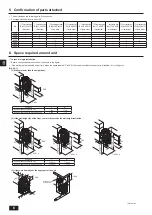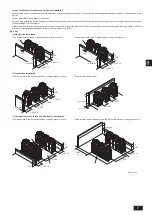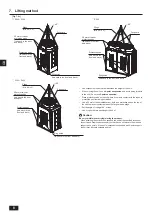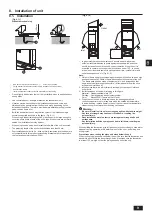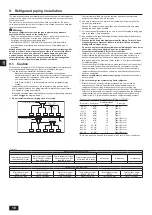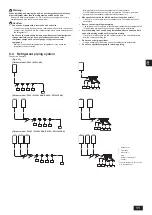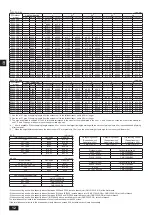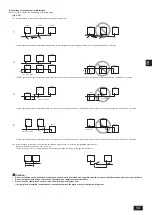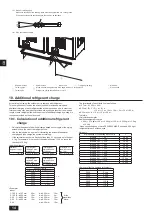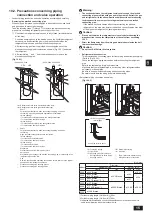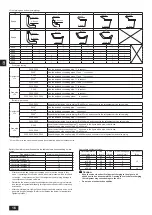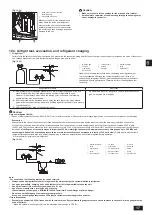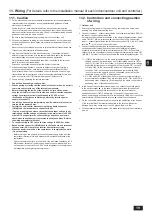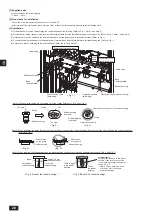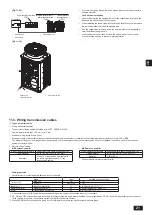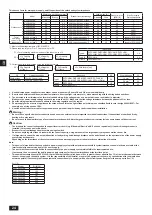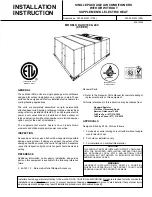
10
GB
9. Refrigerant piping installation
The pipe is connected via a terminal-branch type connection in which refrigerant
piping from the outdoor unit is branched at the terminal and is connected to each
of the indoor units.
The method of pipe connection is as follows: flare connection for the indoor
units, gas pipes and liquid pipes for outdoor units, brazed connection. Note that
the branched sections are brazed.
Warning:
Do not use refrigerant other than the type indicated in the manuals
provided with the unit and on the nameplate.
- Doing so may cause the unit or pipes to burst, or result in explosion or fire
during use, during repair, or at the time of disposal of the unit.
- It may also be in violation of applicable laws.
- MITSUBISHI ELECTRIC CORPORATION cannot be held responsible
for malfunctions or accidents resulting from the use of the wrong type of
refrigerant.
Always use extreme care to prevent the refrigerant gas from leaking while
using fire or flame. If the refrigerant gas comes in to contact with a flame
from any source, such as a gas stove, it breaks down and generates
a poisonous gas which can cause gas poisoning. Never weld in an
unventilated room. Always conduct an inspection for gas leakage after
installation of the refrigerant piping has been completed.
9.1. Caution
This unit uses refrigerant R410A. Follow the local regulations on materials and
pipe thickness when selecting pipes. (Refer to the table on the right.)
1
Use the following materials for refrigeration piping.
•
Material: Use copper alloy seamless pipes made of phosphorus
deoxidized copper. Ensure the inner and outer surfaces of the pipes are
clean and free from hazardous sulfur, oxide, dusts, shaving particles,
oils, and moisture (contamination).
•
Size: Refer to item 9.2. for detailed information on refrigerant piping
system.
2
Always observe the restrictions on the refrigerant piping (such as rated
length, height difference, and piping diameter) to prevent equipment failure
or a decline in cooling performance.
3
Branching cannot be made after header branching (corresponding parts are
marked with in the diagram below).
4
Do not install outdoor unit piping when it is raining.
5
Commercially available piping often contains dust and other materials.
Always blow it clean with a dry inert gas.
6
Use care to prevent dust, water or other contaminants from entering the
piping during installation.
7
Reduce the number of bending portions as much as possible, and make
bending radius as big as possible.
8
For indoor and outdoor branching, be sure to use the following twinning pipe
sets in the table 1 (sold separately).
9
Use an adapter if a specified refrigerant pipe has a different diameter from
that of a branching pipe.
0
Braze only with non-oxide brazing material for piping. Failure to do so
may damage the compressor. Be sure to perform the non-oxidation
brazing with a nitrogen purge.
Do not use any commercially available anti-oxidizing agent since it may
cause pipe corrosion and degrading of the refrigerant oil.
Please contact Mitsubishi Electric for more details.
(Refer to item 10.2. for details of the piping connection and valve operation)
a
Always insulate the piping properly. Insufficient insulation will result in a
decline in heating/cooling performance, water drops from condensation
forming and other such problems. (Refer to item 10.4 for thermal insulation
of refrigerant piping.)
b
When connecting the refrigerant piping, make sure the valve of the outdoor
unit is completely closed (the factory setting). Do not operate it until the
refrigerant piping for the outdoor and indoor units has been connected, a
refrigerant leakage test has been performed, and the evacuation process
has been completed.
c
Never use refrigerant to perform an air purge.
Always evacuate using a
vacuum pump.
d
Be sure to charge the system using liquid refrigerant.
e
Either a lack or an excess of refrigerant causes the unit to make an
emergency stop. Charge the system with an appropriate amount of
refrigerant. When servicing, always check the notes concerning pipe
length and amount of additional refrigerant at both locations, the refrigerant
volume calculation table on the back of the service panel and the additional
refrigerant section on the labels for the combined number of indoor units.
(Refer to item 9.2. for detailed information on refrigerant piping system.)
Copper pipe size and radial thickness for R410A CITY MULTI.
Size (mm) Size (inch) Radial thickness
(mm)
Pipe type
ø6.35
ø1/4"
0.8
Type-O
ø9.52
ø3/8"
0.8
Type-O
ø12.7
ø1/2"
0.8
Type-O
ø15.88
ø5/8"
1.0
Type-O
*ø19.05
ø3/4"
1.2
Type-O
*ø19.05
ø3/4"
1.0
Type-1/2H or H
ø22.2
ø7/8"
1.0
Type-1/2H or H
ø25.4
ø1"
1.0
Type-1/2H or H
ø28.58
ø1-1/8"
1.0
Type-1/2H or H
ø31.75
ø1-1/4"
1.1
Type-1/2H or H
ø34.93
ø1-3/8"
1.2
Type-1/2H or H
ø41.28
ø1-5/8"
1.4
Type-1/2H or H
* Both pipe types can be used for pipe size ø19.05 for R410A air conditioner.
To the outdoor unit
CAP
To the outdoor unit
<Table 1>
Indoor twinning pipe set model
Line branch
Header branch
Lower steram unit model
Less than 200 in total
Lower steram unit model
More than 201 and less
than 400 in total
Lower steram unit model
More than 401 and less
than 650 in total
Lower steram unit model
More than 651 in total
4 branches
8 branches
10 branches
CMY-Y102SS-G2
CMY-Y102LS-G2
CMY-Y202S-G2
CMY-Y302S-G2
CMY-Y104C-G
CMY-Y108C-G
CMY-Y1010C-G
Outdoor Twinning Kit model
PUCY-P-YSKA
PUCY-EP-YSKA
Total outdoor model
P550 ~ P650
Total outdoor model
P700 ~ P1000
Total outdoor model
P1050 ~ P1350
Total outdoor model
EP400 ~ EP650
Total outdoor model
EP700
Total outdoor model
EP750 ~ P1100
CMY-Y100VBK3
CMY-Y200VBK2
CMY-Y300VBK3
CMY-Y100VBK3
CMY-Y200VBK2
CMY-Y300VBK3

